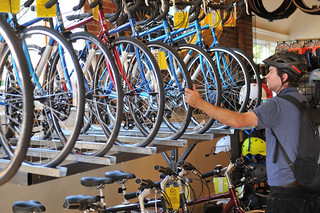It was the sort of dramatic headline that launches a thousand tweets: “In almost every European country, bikes are outselling cars.”
It was true, and it caught our attention. But it skipped a pretty important detail: new bikes have been outselling new cars in the United States for most of the last 20 years, and probably longer.
Wait, bikes outsell cars in the United States? But not, until recently, in Italy, where one in 10 workers nationwide commutes by bicycle? How could this possibly be true?
After reporting on “the return of high-volume U.S. bike frame manufacturing”, we decided to call someone who knows a lot about the subject: Fred Clements, executive director of the National Bicycle Dealers’ Association.
Clements didn’t believe the figures at first, either.
“Really?” he asked.
Really. Even if you include light trucks in the total (a personal vehicle category that represents 1 in 4 U.S. auto sales but doesn’t really exist in Europe), Americans bought 14.4 million new autos last year and 18.7 million new bikes.
Italians, meanwhile, bought 1.4 million new cars last year and 1.6 million new bikes, the first time since World War II that bikes beat cars.
But here’s the thing, said Clements, whose organization represents and serves hundreds of specialty bike shops nationwide: most American bikes sold (“99 percent” of which, he said, are imports) simply aren’t much fun to ride. They’re either heavy or fragile, and that’s part of the reason that thousands of them them are quickly left to rust in garages. It’s a completely different situation from Europe, where most new bikes tend to be “classic three-speeds — [they’re] heavy and they’re utilitarian, but they’re bomb-proof,” Clements said. “They’re not going to break or wear out.”
“A lot of the inexpensive low-end bikes here, they may be cheap but they’ve got a bright paint job,” he went on. “They function, but I think people have a hard time knowing the difference.”
Clements could have been describing my own experience. I rode bikes regularly since I was 10, but until I bought my first upright hybrid (used, for what I thought was an eye-popping $375) I had no idea how comfortable urban biking could be.
And that’s the good news for American biking, Clements said: though most Americans rarely bike, those of us who do have funded constant innovation in the bike industry. That might be one reason why the gas price spike of 2005-2007 might turn out to have longer-term impacts than the oil crises of the 1970s did.
“In the so-called bike boom in the 70s, we didn’t really have any of the depth of styles we have today,” Clements said. When gas prices spiked in 1973, people “went and bought a bike thinking they were going to [commute] and it was a drop-handlebar 10-speed.”
And that was how the previous U.S. bike boom went bust.
“We have so many options now,” Clements said. “Almost every part on that bike has been reinvented, many times more than once. It may look the same, but every part of it has been reengineered.”
That’s why beautiful higher-end bikes like Chris King’s Portland-made Cielo and ambitious, mid-market products like Detroit’s A-Type could be important to the future of biking in the United States. Bikes like these are designed for heavy use, not just rapid sale, and they’re built to last.
In 10 years, we hope hundreds of thousands of Americans who don’t ride today will have learned how great biking can be, and we look forward to living in the safer, healthier, fairer, more prosperous cities that’ll let us create. And if that means bikes will be outselling cars in the United States by even wider margins — just like they have for years in Britain, Germany and France — terrific.
But it’s not buying, owning or getting something that can bring us those benefits. It’s using it.



